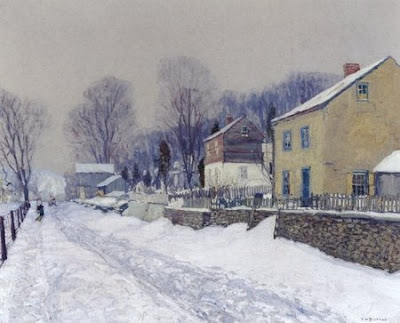Getting Ready for Winter with Edward Willis Redfield
The enchanting landscapes of Edward Willis Redfield are some of the most popular American Impressionist paintings in history. The artist was born in Delaware in late December of 1869. He exhibited artistic talent at a young age and attended the Pennsylvania Academy of Fine Arts and later traveled abroad to England and France. In France, Refield took influences from Impressionist painters Monet, Pissarro, and Thaulow, an artist most famous for his winter scenes.
These painters’ technique of painting en plain-air served as a model for Redfield, and like many Impressionists before him, the Fountainebleu Forest became the subject of his first major break. Road-Forest of Fountainebleu was a turning point in Redfield’s career and helped him procure his first solo show at the Doll and Richards Gallery in Boston. The painting was the first snow scene Redfield took directly from nature, a theme the artist would continue throughout his career.
By 1893, Redfield was married to a London woman he met in his travels abroad. The economic difficulties of the late 19th century drove the couple to the country. Living on a farm in Center Bridge, Pennsylvania, the necessity to live off the land and deal with nature’s unpredictability became inspiration again for the artist. While the shift in economy created an urban world of impersonality and loss of self-discovery, Redfield’s respect for nature deepened. His winter landscapes, perhaps the most compelling of his paintings, were painted in zero degree weather, with blowing winds and freezing snowfall.
In an article from 1906, writer B.J.O. Flower proclaimed that Redfield was a man who confronted life with directness and intensity. This sentiment was shared by many Americans at the time, for the differences between city and country life were always at the forefront of their minds. Even for painters, the difference in character came from a difference in environment.
From 1900 to 1910, Redfield painted a number of snow scenes outdoors in one sitting. The artist wanted to capture the spontaneity of light and color of one day or just a part of a day. In doing so Redfield creates some of the most memorable Impressionist snowscapes from the early 1900’s. In Hillside at Center Bridge from 1904, Redfield depicts the transient effects of light and atmosphere. His swift technique is evident as quick brushstrokes create the dead grasses along the bank, making the painting an immediate experience of the viewer.
The painter was now in the apex of his career. He exhibited at fifteen solo shows and was awarded over twenty-seven prizes for his paintings. His paintings now hang in some of the most prestigious museums in the world.
(The painting below, titled Snow Scene: Lumberville, Pennsylvania sold for $163,800 at auction in June of 2009.)
Works Cited:
Kimmerle, Constance, and Edward Willis Redfield. Edward W. Redfield: Just Values and Fine Seeing. Doylestown, PA: James A. Michener Art Museum, 2004. Print.
http://www.questroyalfineart.com/artist/edward-willis-redfield










